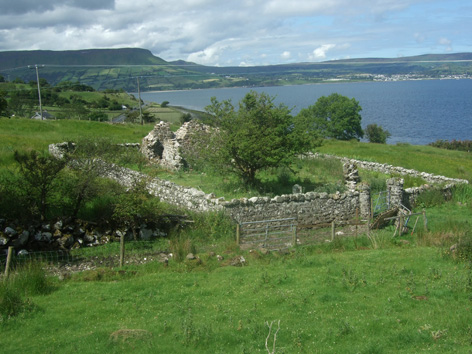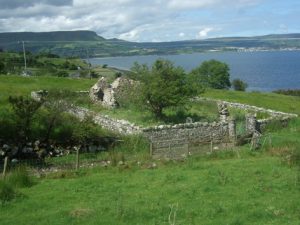
Ardclinis Church and Graveyard
Of historic interest nearby to the trail is Ardclinis Church and Graveyard. Situated on A2 road, approximately 9.2 miles north of Glenarm.
Legend, history and beautiful surroundings
The ruins of Ardclinis Church and Graveyard occupy a beautiful setting overlooking Red Bay in the townland and civil parish of Ardclinis. Situated on the green slope between the basalt escarpment and the shore, this beautiful walled burial ground and church stand in a field above the coast road from Carnlough to Waterfoot, beside a small stream which flows into the sea.
The first church on this site may date back to the early Christian period. We know that “Ecclesia de Ardglanys” was valued at twenty shillings in the ecclesiastical taxation of 1306-1307, but other than that, its history is obscure. Local tradition associates the church with St Mac Nissi, the patron of the Dioceses of Down and Connor, who is said to be buried here. Another tradition links its founding to St MacKenna. In days past, there were several large stones by the roadside, known as MacKenna’s chair. These were reputed to have been blessed by this saint, so that any weary traveller resting on them would arise refreshed, ready for their onward journey.
Ardclinis Crozier
Today the name ‘Ardclinis’ is most widely associated with an important twelfth century artefact, the Ardclinis Crozier. This beautifully wrought pastoral staff, used by a high member of the church clergy, is said to have rested on the ruined window of the old church until about 1760. It is now in the National Museum in Dublin.
The church
The church would probably have had a thatched roof, which has long since disappeared. Today its ruins measure 17.6 metres by 6.4 metres, and the western rubble-built walls survive to no more than 3 metres in height. The eastern end of the church has more or less disappeared and no clear architectural details remain. However, recent works by the Northern Ireland Environment Agency have stabilised the ruins.
The physical decline of Ardclinis church is not a recent occurence. In 1622 it was described as ‘decayed’, while in 1657 it was said to be ‘ruinated’. Indeed, reports from 1679 and 1685 say there was no church in use in the parish. Today we can enjoy the church as much for the remarkable beauty of its surroundings and its legendary history, as for any remaining architectural features.
The graveyard
The small graveyard that surrounds Ardclinis church is enclosed by a more recent stone wall. The entrance gate is flanked by two stone pillars and is reached after a short walk through the adjoining field from the car park at the roadside.
The surface of the churchyard is very uneven. It contains 14 inscribed gravestones, distributed on all sides of the church as well as within its walls. The inscriptions include the following surnames: Barry, Black, Clark, Gillan, Harvy, McAulay/McAuley, McCart/McKart, McKarry/McKerry, Managhan, Murray, O’Mulvena and O’Neill. The graveyard seems to have been used exclusively by Catholics.
The earliest date of death recorded is that of Shean O’Mulvena, who passed away in 1754 at the age of 56; there are several other dates of death in the late eighteenth century. Most are from the early nineteenth century, while there is one from the early twentieth century – Denis Black who died in 1910 aged 76.
The O’Neill stone is worthy of note in that it bears the O’Neill coat of arms and the motto ‘Lam dearg Erin’ – ‘the red hand of Ireland’. It commemorates Shane O’Neill of Discairt who died in 1792 aged 89, and his wife and two sons.
There is a tradition that a family of O’Neills moved from County Tyrone to the Antrim Glens at around the time of the Flight of the Earls in 1607, and from this family the O’Neills of Discairt descended. What can be said is that there was a consciousness on the part of the Discairt O’Neills of a relationship to the ruling O’Neills of Tyrone that they were anxious to emphasise through the carving of the coat of arms on their tombstone.
To the south-east of the ruined church is a large hawthorn trees with stones carefully positioned around its base and decorated with rags, evoking the tradition of the ‘fairy tree’.


